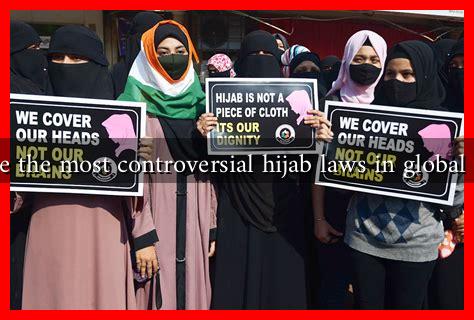-
Table of Contents
What are the Most Controversial Hijab Laws in Global Politics?
The hijab, a traditional headscarf worn by many Muslim women, has become a focal point of debate in global politics. Laws regulating or banning the hijab have sparked significant controversy, raising questions about religious freedom, women’s rights, and cultural identity. This article explores some of the most contentious hijab laws around the world, examining their implications and the reactions they provoke.
The Hijab in Context: A Symbol of Faith and Identity
The hijab is not merely a piece of clothing; it represents a complex interplay of faith, identity, and personal choice. For many Muslim women, wearing the hijab is an expression of their religious beliefs and cultural heritage. However, in various countries, the hijab has become a political symbol, often associated with broader issues of immigration, integration, and secularism.
Controversial Hijab Laws Around the World
Several countries have enacted laws that either mandate or prohibit the wearing of the hijab, leading to heated debates and protests. Here are some notable examples:
- France: In 2004, France implemented a law banning conspicuous religious symbols in public schools, which included the hijab. This law was justified on the grounds of secularism, but it has faced criticism for targeting Muslim women specifically. The law has led to numerous court cases and public demonstrations, highlighting the tension between secularism and religious expression.
- Turkey: Turkey has a complex history regarding the hijab. For decades, the wearing of the hijab was banned in public institutions, including universities. However, in 2010, the government began to lift these restrictions, allowing women to wear the hijab in public offices and schools. This shift has been met with mixed reactions, with some viewing it as a victory for religious freedom, while others see it as a threat to secularism.
- Iran: In contrast to Turkey, Iran enforces a mandatory hijab law for all women, both citizens and visitors. Since the 1979 Islamic Revolution, women have been required to wear the hijab in public. This law has led to widespread protests, particularly among younger generations who view it as an infringement on personal freedom. The “White Wednesdays” movement, where women wear white in protest of the hijab law, has gained international attention.
- Belgium and the Netherlands: Both countries have implemented bans on wearing the burqa and niqab in public spaces. These laws have been justified on security grounds but have been criticized for disproportionately affecting Muslim women. The bans have sparked debates about cultural integration and the rights of minority groups.
Case Studies: The Impact of Hijab Laws
To understand the implications of hijab laws, it is essential to examine specific case studies that illustrate their impact on women’s lives and societal dynamics.
- France: The 2004 law has led to increased stigmatization of Muslim women. Many have reported feeling marginalized and discriminated against in educational and professional settings. A 2019 study found that 62% of Muslim women in France felt that wearing the hijab negatively affected their job prospects.
- Iran: The enforcement of hijab laws in Iran has led to severe penalties for women who defy the regulations. Reports indicate that women can face fines, imprisonment, or even physical violence for not adhering to the dress code. The ongoing protests against these laws highlight the growing discontent among women regarding their lack of autonomy.
The Global Response: Advocacy and Activism
In response to controversial hijab laws, various advocacy groups and movements have emerged globally. Organizations such as Amnesty International and Human Rights Watch have campaigned for women’s rights and religious freedom, emphasizing the need for laws that respect individual choices rather than impose restrictions.
Social media has also played a crucial role in mobilizing support for women affected by hijab laws. Hashtags like #FreeTheHijab and #MyHijabMyChoice have gained traction, allowing women to share their stories and advocate for their rights on a global platform.
Conclusion: Navigating the Complexities of Hijab Laws
The debate surrounding hijab laws is multifaceted, encompassing issues of religious freedom, women’s rights, and cultural identity. While some countries have enacted laws that promote secularism, others have imposed restrictions that infringe upon personal freedoms. As global politics continue to evolve, it is crucial to engage in open dialogues that respect diverse perspectives and uphold the rights of all individuals, regardless of their attire.
Ultimately, the most controversial hijab laws serve as a reminder of the ongoing struggle for women’s rights and the importance of fostering an inclusive society that values personal choice and freedom of expression.


